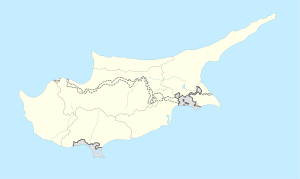Bedesten, Nicosia
| Bedesten, Nicosia | |
|---|---|
 |
|
| Basic information | |
| Location | Nicosia |
| Geographic coordinates | 35°10′34″N 33°21′51″E / 35.1761°N 33.3641°ECoordinates: 35°10′34″N 33°21′51″E / 35.1761°N 33.3641°E |
| District | Nicosia District |
| Country |
|
| Ecclesiastical or organizational status | culture centre |
| Status | Active |
Bedesten or Bedestan is an historical building in the Selimiye quarter of North Nicosia, located directly beside the Selimiye Mosque. The structure has a long and complicated history spanning more than one thousand years. Originally built as a church in about the sixth century, and expanded and rebuilt between the twelfth and sixteenth centuries, it was converted to a bedesten, a type of covered market, during the period of Ottoman rule. It is currently used as a cultural centre.
The earliest history of the Bedesten is documented archaeologically by a Byzantine basilica, fragments of which are preserved inside the current building. These remains, which share some structural features with Afendrika and Ayios Philon, possibly date to the sixth century. T. C. Papacostas has identified these remains as marking the site of the first cathedral of Saint Sophia in Nicosia.
Under the Lusignan kings the subsequent history of the building is not well documented, but some historians, including Camille Enlart, proposed that after the fall of Acre in the late twelfth century, English monks who were followers of Thomas Becket established a new Latin church on this site and dedicated it to St Nicholas. This reading of the sources is not, however, universally accepted in view of the minor role played by the Knights of Saint Thomas in the history of the Latin east. With the adjacent cathedral dedicated to the Latin rite, the Bedesten probably continued to serve an Orthodox role. For reasons and circumstances that are unclear, the church was expanded several times and rebuilt during the fourteenth and the fifteenth centuries. This attests to a thriving position of Greek Orthodoxy despite on going frictions with the Roman church. During the Venetian rule of the island, the Bedesten was used as the metropolitan bishopric building by the Orthodox church, and dedicated to Mary as Panagia Hodegetria.
...
Wikipedia

